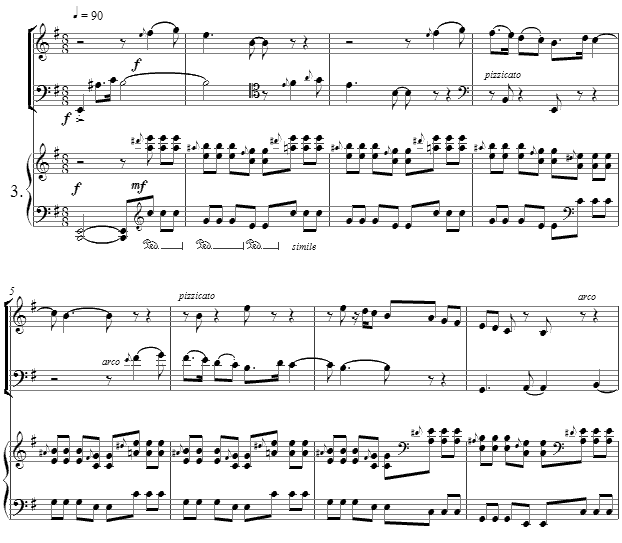Music and Texts of GARY BACHLUND
Vocal Music | Piano | Organ | Chamber Music | Orchestral | Articles and Commentary | Poems and Stories | Miscellany | FAQs
Piano Trio in E minor - 2007
for Emily Ezust
i.
[ 9 pages, circa 2' 45" ]
The opening movement begins with an odd gesture, singly string glissandi for violin and violoncello, culminating in the "a tempo" opening of the movement.
Emily Ezust's amateur piano trio humorously calls themselves the "Gesundheit Trio," with cellist Martha Nabatian and pianist Jenny Ross. Emily wrote me to say, "...the real reason [for the name] is that when we began playing together (about seven years ago), we kept hearing ourselves shouting 'Gesundheit!' between the notes, due to Jenny's allergies."
As to this trio's amusing name, Emily tells the story: "Once, Jenny (our pianist) was standing in line at the Ottawa chamber music festival, and got into conversation with someone who asked if she played an instrument. Jenny replied that she played the piano, and then said, probably with a mischievous twinkle to her eye, that she was part of the Gesundheit Trio. Her interlocutor nodded sweetly and said, 'Oh yes, the Gesundheit Trio. I've heard of you.'" Ergo, this opening gesture prepares a 'sneeze' to recall that anecdote.
The harmonic kernel of this movement rests on the juxtaposition of E minor in second inversion against D sharp minor in first inversion, over which an informal "caccia" for the strings sings out.
The middle section continues the imitation between violin and violoncello as the piano underpins the "chase" with a rhythmic motor.
ii.
[ 3 pages, circa 2' 45" ]
This slow movement opens with the same harmonic kernel, D sharp minor against E minor, before the solo strings sing out a developing disjunct, chromatic dialogue over a simple, sustained piano accompaniment.
iii.
This accompaniment for this movement is built on the subdivision of the duple meter into 3-3-2, as the A minor to E minor to C major chord succession in the accompaniment is repeated as a passacaglia-like background over which yet another dialogue between the strings occurs. With the exception of the non-harmonic appoggiaturas, this movement's melodies are built on the natural minor.
For a moment the strings and piano swap function, as the piano makes the melodic statements, before a return to the opening as a recapitulation.
iv.
[ 9 pages, 3' 15" ]
The last movement opens with a recollection of the third movement's rhythmic structure, 3-3-2, serving as an introduction to a formal duet for the strings. The piano accompaniment under the duet restricts itself to four note, arpeggiated gesture (as shown below) in which the chord's members change with accidentals to variations of the same structure, moving from one related chord to another as the duet responds to the harmonic shifts.
[ Total of 26 pages, circa 11' 45" ]
Emily Ezust
Emily Ezust is a computer programmer living in Ottawa, Canada. Wife and mother, she says " I grew up in a musical family (the four of us often played string quartets for fun when we were all living in one house), and I still play the violin with great pleasure (entirely nonprofessionally), with semi-regular piano trios and string quartets."
In 1995, she began a web site while working at McGill University (Montreal) on her Master of Science in the computer sciences, creating The Lied and Art Song Texts Page, a free web archive of texts and translations to Lieder and other art songs, as well as choral texts, madrigals and part songs. This fine site and resource's URL is www.recmusic.org/lieder/ and is highly recommended by me.
The score for the Piano Trio in E minor is available as a free PDF download, though any major commercial performance or recording of the work is prohibited without prior arrangement with the composer. Click on the graphic below for this chamber score and parts.
Piano Trio in E minor - full score
Piano Trio in E minor - violin part
Piano Trio in E minor - violoncello part







